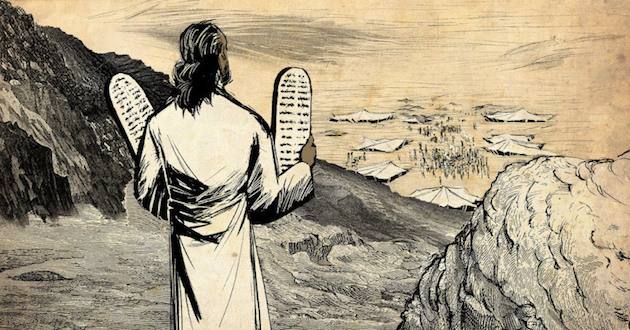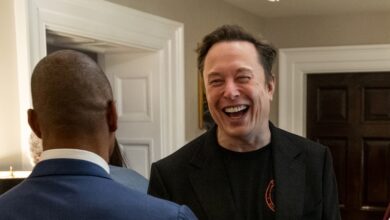YouTube is how millions are seeing The Bible Project videos, and it’s amazing

Millions of people worldwide are being reached by an animated video called The Bible Project. The success to promote it to such a wide extent through the support of crowdfunding and its viral spread on YouTube.
“We want people to experience the Bible as the unified story that leads to Jesus, a big meta-narrative that leads to Jesus,” Mike McDonald, director of Strategic Relationships of The Bible Project says.

“Why that’s even a thing for us, is that our founders, and people like myself, and many others often just find it difficult to read the Bible. It’s a massive book [with] many different authors, many different times in history, different literary styles. It’s such a complex group of books that it becomes very difficult on how to even approach it,” he said.
The Bible Project was launched in 2014 in Portland, Oregon, and hopes to encourage people to engage with the scriptures.
“At least in our communities, we’re fast approaching a very post-Bible Christianity,” McDonald stressed.
The former pastor said he comes across Christians all the time who do not often open their Bible or are excited about it.
“We wanted to solve that. The biggest reason why people don’t read the Bible is because we don’t understand the context, we don’t know how to approach the books, or the chapters that we’re reading,” he said.
Since its inception, The Bible Project has produced over 130 videos and 200 podcasts, accumulating 125 million views across all media channels in over 200 countries.
The outreach tool was started by longtime friends Timothy Mackie and Jonathan Collins who met at Multnomah Bible College. The pair wanted to help people read through scripture while avoiding common pitfalls of misunderstanding the Bible. Combining Mackie’s doctorate in theology and his deep understanding of the Hebrew Bible with Collins’ ability to simply communicate complex topics and his passion for visual story-telling, they chose to create teaching videos and put them online for free.
The Bible Project was an instant success and with people willing to give for the creation of the videos, they now have more than 100,000 supporters.
“Tim had this idea of doing something called, Bible in five. He wanted to do overview, explanation type videos, of books of the Bible, in five minutes so that everyday people that aren’t going to go to seminary can have enough context and information to go in and actually read the Bible,” McDonald said of his colleagues.
“Jon became so good at communicating that he created two companies in Portland that Microsoft, Apple and Google would all hire when they were launching new, complex ideas. He would help them figure out how to communicate that in 30 or 60 second commercial slots.”
The Bible Project is the “merging of those two people and those two things” he added. “You’ve got this incredible Bible scholar, and this incredible question asker/communicator, and you put them together, and that’s the Bible project.”
It’s not just young, it’s every age group, we have so many folks that are in their mature 60s and 70s that love learning the Bible through our videos, but we also have eight-year-olds that are just as engaged in the video.
The team collectively now create explainer videos on the Bible and hire the best artists from around the world to come and be a part of the project. They’ve even worked with talented illustrators from Pixar to bring some of their projects to life.
“You can just do so much more with animation than you can, with just Tim [teaching] with a whiteboard. There’s just so many crazy, complex ideas when we’re talking about God, or the Holy Spirit. How do you do that in just a live teaching?” McDonald reflected. “So we have the freedom to actually do animation around those complex ideas and help communicate them.”
“It’s not just young, it’s every age group, we have so many folks that are in their mature 60s and 70s that love learning the Bible through our videos, but we also have eight-year-olds that are just as engaged in the video,” the Director of Strategic Relationships revealed.
Reaching the unchurched
The project is in the top 225 of all-time podcasts. Their videos on YouTube are also specifically viewed by people between the ages of 18 to 45, and is particularly strong in males ages 18 to 35.
When asked about their remarkable ability to reach the unchurched, McDonald said it’s really because of how they deliver their content.
“I wish that we came up with some big strategic plan at the very beginning, but to be honest, part of it is the fact that we chose two things. We chose YouTube as our primary platform when we first launched the project and there were a couple of reasons for that,” he explained.
“One, we always wanted it to be free and YouTube allowed us to do that, where it didn’t cost us to upload videos and create channels and all that kind of stuff. Two, we knew that YouTube is still, to this day, and is only growing as the number one media consumption platform in the world, not just here in America, but around the world. More people watch media on YouTube than any other platform,” McDonald added.
In spite of concerns that social media censors the Gospel message, McDonald maintained that YouTube has actually helped them reach millions of people.
The Bible Project has “evidence to the contrary” he said.
“What’s amazing with YouTube is that there’s a YouTube cadence, meaning that if we made our videos slower in the cadence, we would drop off views and people wouldn’t finish them,” he shared. “We know the cadence of the most-watched videos and we keep our videos in line with that media consumer cadence so that our videos get finished at a very high percentage rate and YouTube loves that because they want to keep people on their platform.
“YouTube actually, forwards people, that have never heard of the Bible project to our video, depending on some of their search history. So about 50% of our YouTube views come from YouTube actually pushing our content to them. I think we’re reaching quite a few unchurched or non-believers through YouTube pushing our content, because of the way that we do it.”
The project is especially helpful because so many people have many questions about the Bible and YouTube is where many in this generation turn for answers.
Another reason they are reaching the 18 to 35-year-old male demographic that the churches often having a hard time reaching, is because “YouTube skews that way,” McDonald noted. “YouTube skews 18 to 35-year-old male, that’s the majority of people that are on YouTube.”
Whether you’re in church or not there, there’s still a massive group of people that are wanting answers and wanting to know what their purpose is on this life.
“Over 50% of our views is coming from that group of people,” the director who has led thousands of Christian leaders on more than 200 trips around the world, shared.
“Whether you’re in church or not there, there’s still a massive group of people that are wanting answers and wanting to know what their purpose is on this life. They’re looking for a place to actually engage with their spirituality, whether they are followers of Jesus or not. There’s still this deep-rooted connection to that and because of the way that we do our explainer videos, they just end up being in a place that, whether it’s non believers, or faith-friendly people, or brand new Christians, or people that have walked away from the church, they are still trying to figure out how to engage in their spirituality, they’re finding our videos extremely helpful,” McDonald says.
20-year-old youth leader and AdventHealth University student Emma Mantlo says she strongly “supports” the video project and revealed that she’s had professors use the information to help teach students to understand scripture.
“Many professors who taught Bible classes I attended used the Bible Project as a reliable tool to summarize a book or help create an overview of the Bible and how everything comes together as God’s beautiful plan to save humanity,” Mantlo shared.
She added, “I have consistently gone back to this resource to have varying input on all details surrounding different books, words, and themes.”
The non-profit Bible Project operates solely through crowdfunding.
“We didn’t go into this thinking we’re going to make 18 to 20 videos a year,” McDonald acknowledged. “We thought maybe we’d get two out, maybe three. By God’s grace, the crowd caught up very fast, through a few people that helped share it.”
Public Christian figures Pastor Francis Chan and Jefferson Bethke were instrumental in spreading the word early on by sharing the videos with their audiences.
“Now we have just an army of incredible generous patrons that keep the project going. It’s primarily average donations of $20 a month but we have tens of thousands of them, that allow us to keep this project going,” McDonald testified.
“It’s a bit of an affirmation that people are finding it helpful. It’s only growing in that support, which just allows us to continue to make 18 to 20 videos a year, plus translate them into 54 different languages, and get these localized videos out into the world as well.”
The Bible in different languages
The Bible Project ventured out into the Spanish market just this year and already surpassed 200,000 subscribers on YouTube.
“I don’t think we ever thought this many people would be engaging and finding the videos helpful. There is such a lack of great resources that are free for people around the world. Spanish was the first language we kicked off,” said McDonald.
With over 100 videos already done in Spanish, each video is localized featuring Spanish artists. The Bible Project doesn’t simply do voice-overs for their international video either, they select local people to share the video content in their native tongue.
“We actually re-animate, redraw, through local indigenous folks that are doing the art and are doing all the voiceover. We do full translation. It’s full-on,” McDonald disclosed. “It takes a while but we end up with a product that really feels like it was built for that context and for that people group.”
The Bible Project also has videos in Hungarian, Polish, Cantonese, French, German, Russian, Vietnamese, Indonesian, and Mandarin which are all at different stages.
“Some of the newer ones, we’ve only got 15 or 20 videos done, but those are all YouTube channels that people can access right away in their countries and in their context,” he noted.
The goal is to have videos in 54 languages in the next seven years, with each video fully localized.
The Bible Project regularly supports organizations and churches who wish to integrate their videos into sermons and teachings. The crowdfunding has made it possible for McDonald to travel and assist in doing so.
Worship & Creative Pastor Jeffrey Abyad of Capital Life Church, Arlington, Virginia, said his church community joined a YouVersion Bible reading plan for a year that incorporated The Bible Project videos.
“We loved it. The visuals are such an illuminating way to look at scripture, and the theological depth of concepts distilled into such an interesting and easily understandable format have been invaluable,” Abyad admired.
“It has re-energized my hunger for the word in a whole new way. I’m very grateful for the Bible Project — their passion for God’s word and their creativity and dedication to sharing their insightful content with the world free of charge,” he supported.
North Point Ministries Pastor Andy Stanley in Atlanta, and Celebration Church in Jacksonville, Florida, have both been known to use the project in their ministries. Celebration Church has fully integrated The Bible Project into their services. They play a video every Sunday in front of their entire gathering as well as in their kids and youth groups.
Nonprofit organizations such as Cru, Young Life, Alpha, Prison Fellowship, and Bible Study Fellowship further integrate the teaching videos.
Because it’s done on YouTube and focuses solely on scripture and biblical history, the project allows for multiple denominations to use the video. The Bible Project avoids partnerships with ministries or organizations to avoid mis-associations. The outreach tool encourages everyone to use their videos as long as the content remains free and they use YouTube links.
“If you’re on YouTube, the way that YouTube works is I can put a Beyonce video on my Facebook from YouTube, it doesn’t mean that I know Beyonce or am partnered with Beyonce,” McDonald reasoned. “That’s allowed us to stay very ecumenical in our approach to serve the big C church, whether it’s Pentecostal, Protestant, Catholic, or whatever.”
“The goal is to help people! We’re the Bible project, not the theology project. We’re just talking about what the Bible is saying, in that context for that moment.
“The foundation that we’ll lay down will be extremely helpful for you and your church, and then if you take it a little bit further, that’s up to you as a shepherd, as a pastor, to shepherd your people in that way,” he said.
The video does not subscribe to a particular Bible translation as Mackey is fluent in Hebrew and studies from the word from that translation, then explains it in English.
The ultimate goal for them would be to turn the corner on the Bible Christianity side of things, and really move the needle in people being able to actually read the Bible with confidence, McDonald concluded.
“Jesus taught from the Bible all the time. So if it was important to Him, in His ministry, to teach from texts that were a thousand, 1,500, 2,000 years old, then I think it’s got to be important to us,” he concluded. “At the end of all of this, if we have people go, ‘I love to read the Bible. I get excited about it, It’s crazy, It’s weird, It’s interesting, but I dive into it,’ that would be a huge win.”
Check out The Bible Project on YouTube. For more information visit the website.







